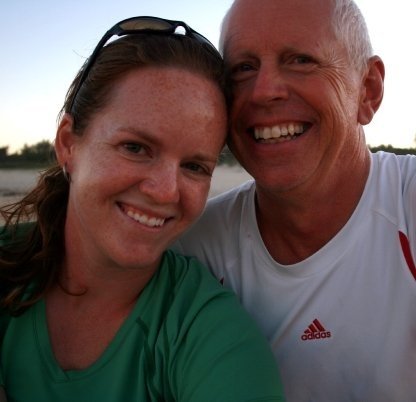
We raced another safari group to Dune #45, which is a mid-sized dune that happens to be easily accessible and gives a great view from the top. It was a difficult climb - soft sand that makes you sink backwards with every step. We trudged up the ridge of the dune in the dark and eventually reached the peak about half an hour of slogging. It was definitely an early morning cardio session to remember! At the top, we sat down along the crest, perched high above the desert and surrounded by massive red dunes on both sides of the pan. The sun started to rise in the east, and as it came up, the dunes began to glow a beautiful golden red hue that became so intense that they almost appeared to be on fire. It was a fire that is hard to describe - surreal, magestic, and insanely beautiful. Sitting on the top of the group in virtual silence, just taking in the moment, made us feel very small - that's for sure. When the heat started to make an appearance and our stomachs started to rumble, we made the much easier descent (some ran straight down the face of the dune!) and enjoyed a fabulous breakfast of scrambled eggs and bacon. As we piled back onto the truck, many of us agreed that the whole experience ranked near the top of the most memorable and/or beautiful things we had ever experienced.








We carried on westward down the long, straight road that bisected the whole pan and ended up at a spot called Sossusvlei, which is where the dunes cut off the pan. The word "vlei" means "end", and "sossus" has something to do with water, so "Sossusvlei" is the place where water ends at the dunes. We were driven out to the current Sossusvlei, but we learned that when the dunes cut off the desert, Sossusvlei will move to a new spot farther upstream. There is also a "Dead Vlei", which was Sossusvlei at one point in time, about 900 years ago, when the dunes cut off the vlei and it became isolated, depriving the trees in the vlei of water. The Dead Vlei was an amazing spot, where the blackened, mangled trees stand on bleached white clay, with towering red dunes behind and a bright blue sky above. It made for some postcard-worthy photos, one of which really resembles the cover of the Namibia Lonely Planet guidebook.
A local San Bushman named Frans led us around the area, explaining the environment and the ways his people use the desert resources to survive in such a harsh environment. Frans was one of the darkest people we've ever seen - with the biggest white smile you've ever seen too. He could make it big with an advertising deal with Colgate. Side note: he also wears no shoes! Even when the sand gets extremely hot during the day (up to 80°C), he still goes barefoot. I finally gave up on dumping the sand out of my shoes, and I attempted to go barefoot, but that didn't last long, as the hot sand burned the moment I took a step. Frans's feet must have soles an inch thick! Or maybe he has just fried all the nerves. That's much more likely!

Some of the things Frans showed us in the desert:
- the "ostrich salad" plant will bloom in a matter of seconds with the addition of only a few drops of water, even if the plant is dead and dry
- a certain type of spider builds tubular nests down to 1.2 metres below the sand surface, with a webbed trap door that is designed to keep sand out
- when water is available, they fill ostrich eggs and bury them at known locations in the sand, with a dried tree root poking out so you can suck water up out of the egg as needed
- identified a variety of tracks and dens of mice, lizards, beetles, snakes, rabbits, and scorpions
- a melon called "!Nama" (the ! is one of five audible clicks in the Khosian language) grown in the desert and will provide enough water for an oryx for two days if eaten
- a particular type of tree produces banana-shaped seed pods that will germinate when an oryx eats the pod and poops it out, as the digested seed gets water from the animal's system
He was full of crazy desert facts, and it was amazing to learn some of the customs of such a traditional culture. We also spotted a bunch of ostriches, springbok, and oryx on the ride back to the truck.



Back at camp, we packed up in the sweltering heat and made our way north for about an hour to a tiny pitstop called Solitaire (supposedly the smallest town in Namibia). It was basically a small lodge, campground, gas station, and a rough gravel landing strip with a sign that said "Solitaire International Airport" - hilarious! We enjoyed some home made kudu stew (tasty!) and some famous Solitaire apple pie before calling it a night. Today was definitely the best day of our trip so far - those red dunes were amazing, and I hope we never forget the landscapes we saw today.





nice sunburn ken! glad to see pamela's doing well making you wear your sunscreen - you'll be dark like Frans in no time!
ReplyDeletei LOVE LOVE LOVE the photo of the black tree/sticklike thing. V cool.
Definitely know the exhaustion of hiking up sanddunes....we did it while suffering the Montezuma's Revenge in Morocco, but still worthwhile. Still though, running down the face was the best part. I highly recommend it and hope you did that :)